Composable commerce is a modern approach to ecommerce that allows companies to select and integrate various “best-of-breed” solutions. This methodology helps create highly adaptable ecommerce systems customized to specific business needs. Composable commerce leverages modular architecture, often based on microservices, APIs, and cloud services, to ensure flexibility and scalability.
Every team can select the components they require based on their digital needs with this approach and you may also need an expert to provide composable commerce solutions to create an exceptional storefront.
ON THIS PAGE
13 Best Composable Store Examples
This highlights the agility and flexibility composable commerce platforms offer, allowing businesses to adapt quickly to market changes and customer needs.
In this blog, we will explore various successful composable commerce examples analyzing their features, benefits, and potential drawbacks.
1. Miko
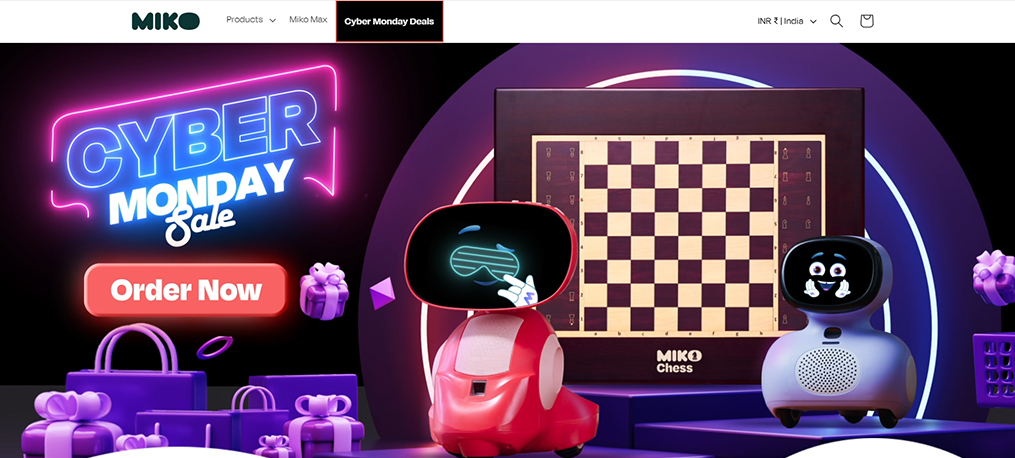
Miko is an innovative ecommerce platform that leverages composable commerce to integrate cutting-edge artificial intelligence (AI) technology. This integration is geared towards creating personalized shopping commerce experiences, aiming to connect more intuitively with customers.
Miko offers tailored product suggestions and custom content by using AI to analyze customer behavior and preferences, enhancing user engagement and satisfaction.
Features
- AI-driven Personalization: Utilizes machine learning to analyze user behavior and preferences, offering customized product recommendations.
- Interactive User Interface: Features an engaging UI that adapts based on user interactions, enhancing the shopping experience.
- Real-time Analytics: Integrates real-time data processing to offer insights into customer shopping patterns and inventory management.
Industry: Consumer Electronics
Founded: 2015
Headquarters: Mumbai, MAHARASHTRA
Company size: 201-500 employees
2. Jollyes
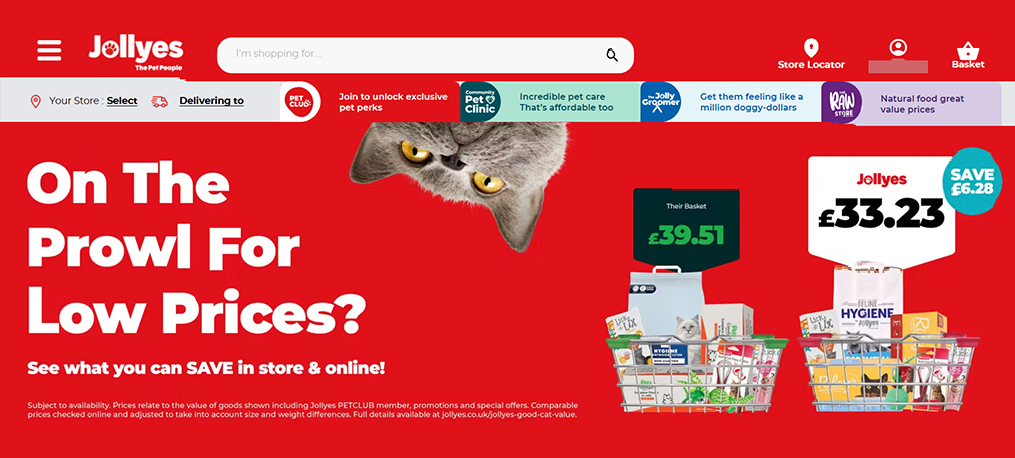
Jollyes, a well-established pet supply retailer in the UK, has adopted composable commerce to streamline its operations and improve customer service. Their platform seamlessly combines various composable commerce solutions to manage everything from inventory to customer relationships.
This approach allows Jollyes to maintain a high level of service across its physical and online stores, ensuring that pet owners find everything they need.
Features
- Omnichannel Integration: Connects online and in-store operations to provide a unified customer experience.
- Advanced Inventory Management: Employs sophisticated algorithms to predict stock levels and automate replenishment.
- Customer Relationship Management (CRM): Integrates CRM tools to maintain detailed customer profiles and personalize service.
Industry: Retail
Founded: 1971
Headquarters: 1 Lea Road, Waltham Abbey, Essex, EN9 1AS, UK, GB
Company size: 1,001-5,000 employees
3. Phoenix Next

Phoenix Next, a technology-focused ecommerce company, uses composable commerce to create a highly adaptable and scalable online platform. Their strategy centers around a mobile-first approach, recognizing the growing trend of smartphone use in online shopping.
Phoenix Next’s platform is designed to provide an optimal mobile user experience, with fast load times, intuitive navigation, and seamless checkout processes, setting a standard for mobile commerce efficiency.
Features
- Mobile Optimization: Prioritizes mobile-first design ensuring the site is optimized for mobile devices, improving user experience and accessibility.
- Scalable Infrastructure: Built on a flexible composable architecture that supports scalability as the ecommerce business grows or as traffic fluctuates.
- Enhanced Security: Implements advanced security protocols to protect user data and transactions.
Industry: Comic book publishers
Founded: 1971
Headquarters: Bangkok
4. Best Online Cabinets
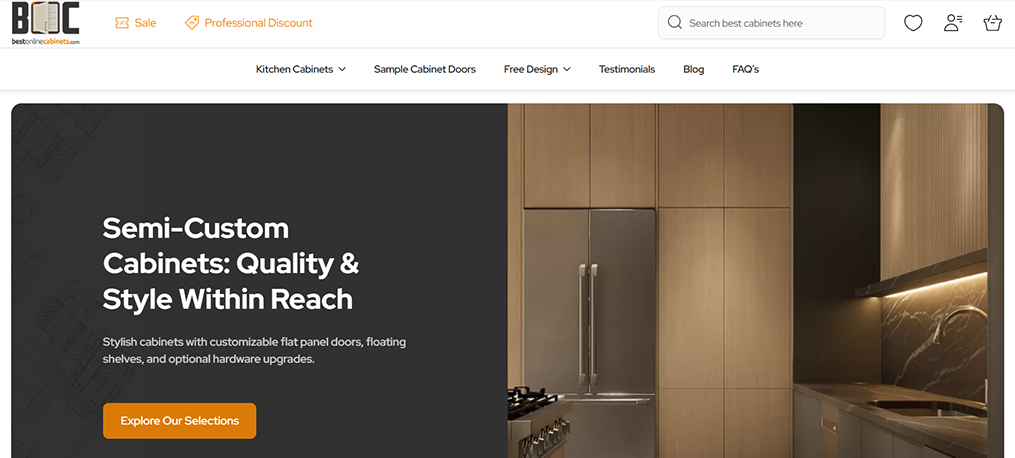
Best Online Cabinets specializes in high-quality and affordable kitchen cabinets through an online platform that epitomizes the essence of composable commerce.
Their composable system integrates various modern technologies to offer a customizable shopping experience, enabling customers to visualize different cabinet setups in virtual kitchen spaces. This tailored interaction helps clients make more informed decisions by seeing potential outcomes before making a purchase.
Features
- 3D Visualization Tools: Offers customers the ability to visualize their custom cabinet designs within their actual kitchen spaces using augmented reality.
- Modular Product Design: Enables customization of cabinets in terms of size, material, and color.
- Integrated Logistics: Streamlines the supply chain with real-time shipping updates and order tracking.
Industry: Cabinet and Worktop Shop
Founded: 2012
Headquarters: Proctor Ave, City of Industry, CA
5. LoveCrafts
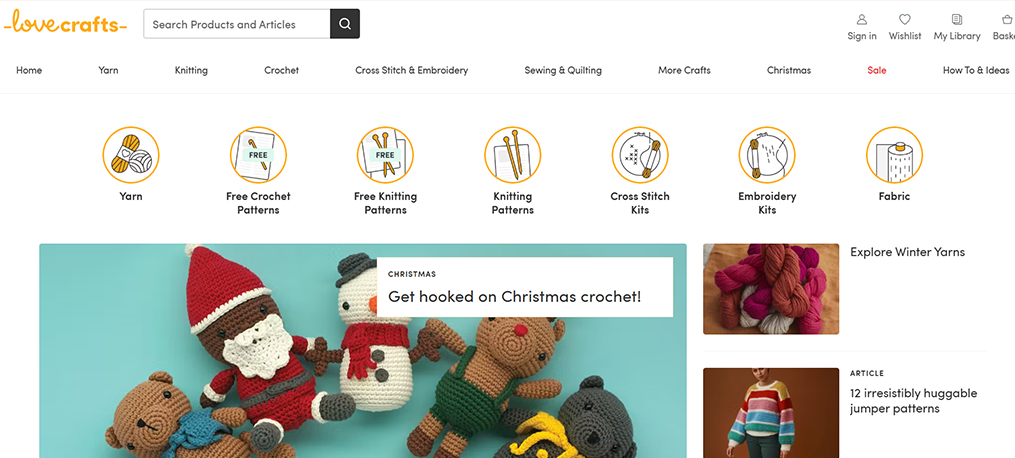
LoveCrafts, an online marketplace for craft supplies, utilizes composable commerce to cater to a niche market with a highly personalized online shopping experience. Their digital platform connects passionate crafters with the supplies they need and includes community features like forums and project sharing.
This community-centric approach, supported by a composable infrastructure, fosters a strong sense of belonging among users, enhancing customer loyalty and satisfaction.
Features
- Community Engagement Tools: Incorporates forums, project sharing, and interactive guides to foster a community around crafting.
- Personalized Content Delivery: Delivers content such as tutorials and patterns based on user interests and past interactions.
- Ecommerce and Social Integration: Seamlessly connect the shopping experience with social media for sharing and inspiration.
Industry: Technology, Information, and Internet
Founded: 2013
Headquarters: 10 Bloomsbury Way, London, WC1A 2SL, GB
Company size: 51-200 employees
6. Pella
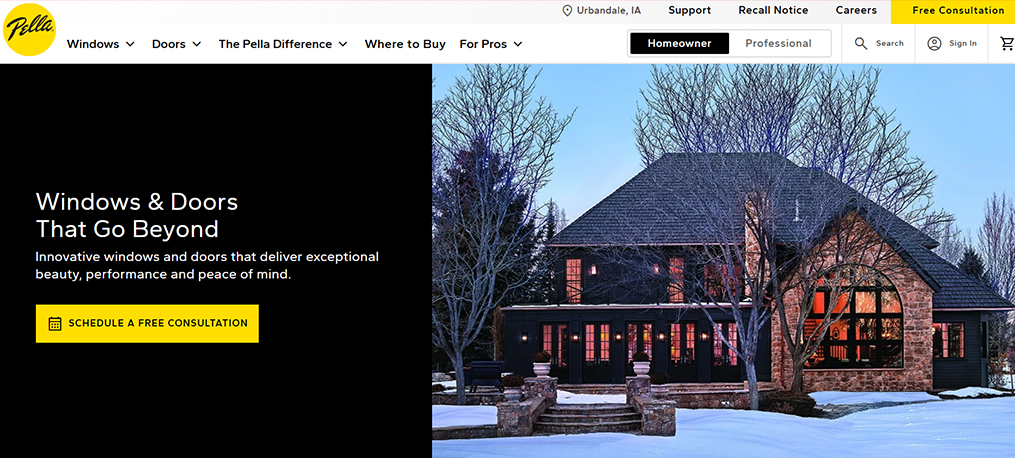
Pella, a renowned manufacturer of windows and doors, employs composable commerce to provide a seamless, integrated customer experience across all touchpoints.
Their platform allows customers to customize products to exact specifications, view them in a variety of settings through augmented reality (AR), and receive personalized service. This holistic composable commerce approach not only improves customer satisfaction but also streamlines operations and enhances operational efficiency.
Features
- Product Customization Interface: Allows customers to specify dimensions, materials, and styles for windows and doors.
- Augmented Reality Preview: Customers can see how products will look in their actual environment before purchasing.
- Integrated Service Scheduling: Enables online appointment booking for consultations and installations.
7. Moteefe
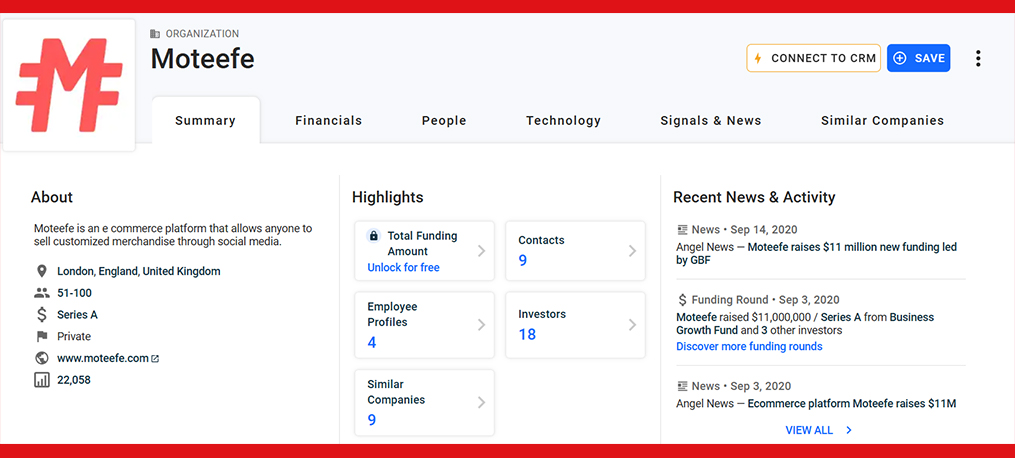
Moteefe, an ecommerce platform designed for creators to sell custom merchandise, harnesses the power of composable commerce to offer extensive customization and scalability.
Their model supports creators with no upfront costs by providing a platform where they can design, promote, and sell their merchandise, all backed by Moteefe’s robust supply chain and fulfillment services.
Features
- Creator-centric Dashboard: Provides tools for creators to design, launch, and manage merchandise campaigns.
- On-demand Production: Uses just-in-time production to minimize waste and reduce costs.
- Global Fulfillment Solutions: Supports worldwide shipping, allowing creators to sell globally without logistical headaches.
Industry: Technology, Information and Internet
Founded: 2016
Headquarters: London, England
Company size: 11-50 employees
8. Burrow
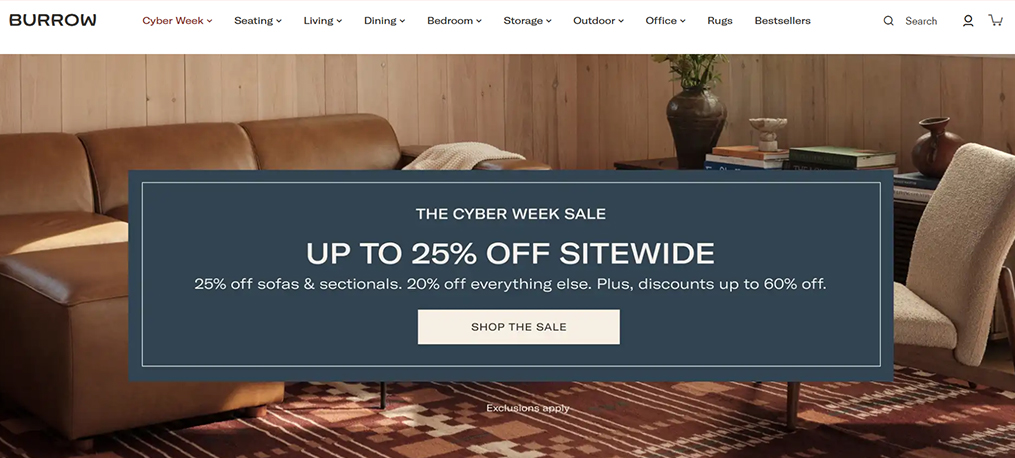
Burrow is an online furniture store that uses composable commerce to offer modular furniture tailored to modern consumer needs. Their platform allows customers to customize products such as sofas and chairs to their space and style preferences.
Burrow’s use of innovative design and direct-to-consumer shipping optimizes both the shopping experience and logistics efficiency.
Features
- Modular Design Configurator: Customers can customize furniture pieces to fit their space and needs.
- Direct-to-Consumer Shipping: Cuts out the middleman to reduce costs and improve delivery times.
- Sustainability Focus: Uses eco-friendly materials and processes in product design and packaging.
Industry: Furniture and Home Furnishings Manufacturing
Founded: 2016
Headquarters: New York, NY
Company size: 51-200 employees
9. Cymax
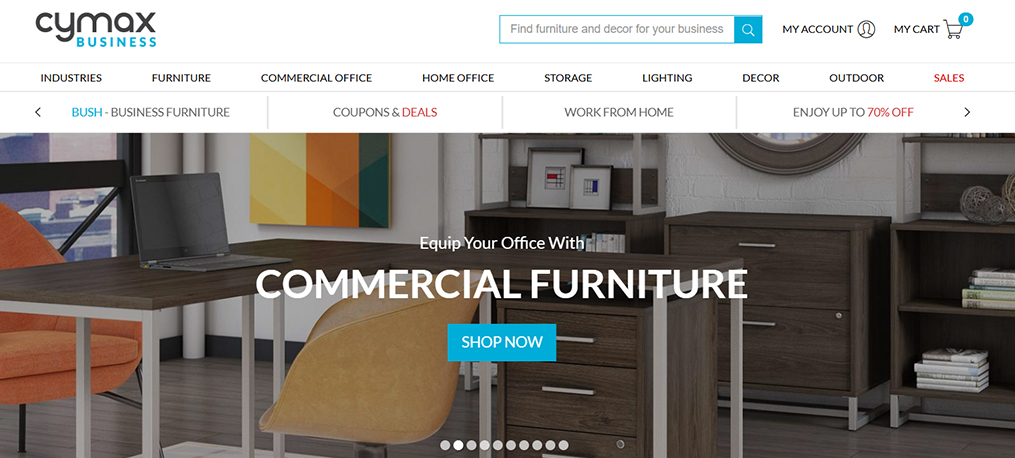
Cymax, operating in the competitive furniture space, utilizes composable commerce to integrate various backend systems like inventory and customer relationship management.
This integration enables a seamless flow of information across all digital channels, improving efficiency and customer service.
Features
- Integrated ecommerce Systems: Combines inventory, customer service, and order management into a cohesive platform.
- Dynamic Pricing Tools: Automatically adjust prices based on market demand and inventory levels.
- User Experience Optimization: Focuses on streamlining the navigation and checkout process for better conversion rates.
Industry: Furniture and Decor
Founded: 2004
Headquarters: Burnaby, British Columbia
Company size: 201-500 employees
10. Ted Baker

Ted Baker, a globally recognized fashion brand, employs composable commerce to offer a flexible, responsive online shopping experience that reflects its stylish brand ethos.
Ted Baker ensures that its online presence is as dynamic and fashionable as its in-store experience by modularly integrating technologies for inventory, ecommerce, and customer engagement.
Features
- Brand-centric Design: Ensures that every element of the online store reflects the brand’s unique style and ethos.
- International Market Support: Offers multi-currency and multi-lingual support to cater to a global audience.
- Advanced Analytics: Employs detailed analytics to track user behavior and tailor marketing strategies accordingly.
Industry: Retail Apparel and Fashion
Founded: 1988
Headquarters: UK
Company size: 1,001-5,000 employees
11. Zenni Optical
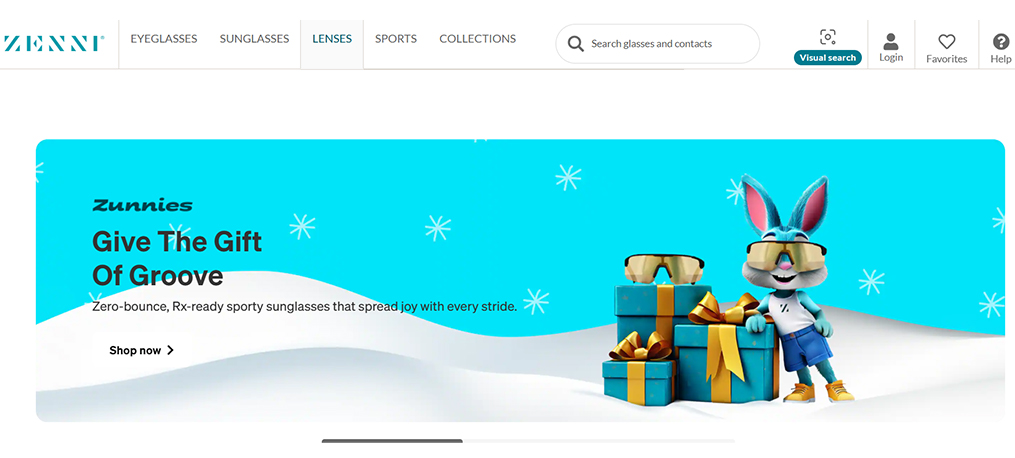
Zenni Optical, a leader in online eyewear sales, uses composable commerce to enhance its online platform with features such as virtual try-ons and detailed customization options for glasses.
This approach improves the customer experience by allowing business users to see how frames look on their faces virtually and also streamlines the path to purchase.
Features
- Virtual Try-On Technology: Allows customers to try glasses on using their webcam to see how frames fit their faces virtually.
- Extensive Customization Options: Offers a wide range of lenses and frame adjustments for personalized eyewear.
- Interactive Eye Health Education: Provides educational content about eye health and eyewear care.
Industry: Manufacturing
Founded: 2003
Headquarters: Novato, CA
Company size: 201-500 employees
12. Teilor
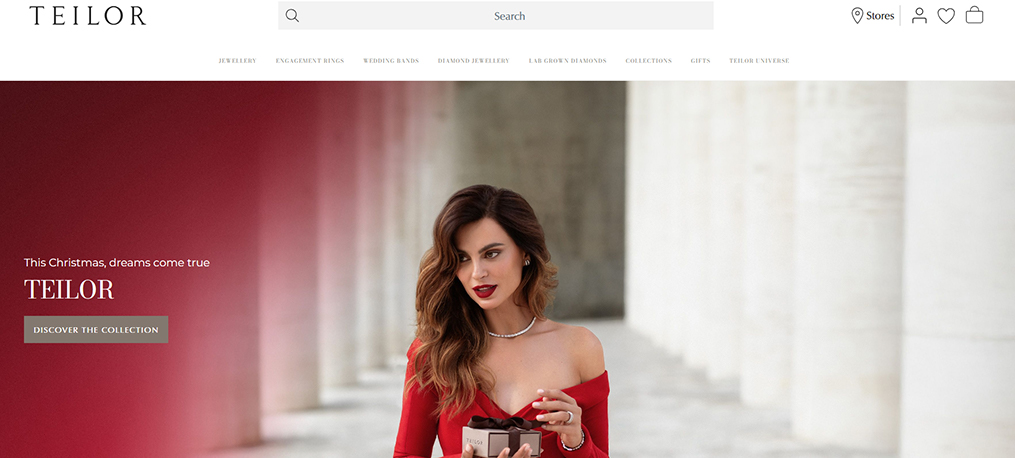
Teilor, a fine jewelry retailer, leverages composable commerce to provide an exquisite online shopping experience that matches the luxury of its products. Their platform integrates high-quality visuals, detailed product information, and personalized customer service to create an engaging and trustworthy online environment for purchasing high-end jewelry.
Features
- Best User Interface: This creates a premium browsing experience with high-quality images and interactive product displays.
- Personal Shopping Assistant: Features chatbots and live customer service for personalized shopping assistance.
- Secure Transaction Protocols: Ensures high-level security for transactions, protecting sensitive customer information.
Industry: Retail Luxury Goods and Jewelry
Founded: 1998
Headquarters: București, București
Company size: 201-500 employees
13. Winkelstraat.nl

Winkelstraat.nl, a premium fashion ecommerce site in the Netherlands, utilizes composable commerce to offer a curated, high-end shopping experience.
They combine luxury fashion with advanced web technology to provide a seamless and sophisticated shopping experience that caters to fashion-conscious consumers.
Features
- Curated Fashion Selection: Offers a handpicked selection of high-end fashion items from renowned designers.
- Real-time Stock Updates: Ensures that the inventory displayed online is accurate and up to date.
- Personalized Style Recommendations: Uses customer data to suggest items that match their style and previous purchases.
Industry: Technology, Information and Internet
Founded: 2012
Company size: 11-50 employees
Read Also: Compossable vs. Headless Ecommerce
Key Trends and Statistics in Composable Commerce
| Increase in Digital Buyers: Statista reports that in 2021, over 2.14 billion people worldwide were expected to buy goods and services online, up from 1.66 billion global digital buyers in 2016. This steady rise underscores the increasing importance of robust ecommerce platforms that scale and evolve with customer demand. Customization Drives Sales: According to a study by Deloitte, one in five consumers who expressed an interest in personalized products or services are willing to pay a 20% premium. This demonstrates the significant value that personalization and customization, key components of composable commerce, add to the consumer shopping experience. Mobile Commerce Growth: A report from Adobe found that nearly 58% of site visits to U.S. retail websites came from mobile devices, and these mobile visits accounted for 42% of total online sales. This statistic emphasizes the importance of mobile-first design, a common feature in many composable commerce platforms, reflecting changing consumer browsing and buying habits. |
Differences Between Microservices and Platform-Based Commerce (PBCs)
According to Gartner organizations that have adopted a composable approach will outpace competition by 80% in the speed of new feature implementation in 2023.
When discussing composable commerce, it’s important to understand the underlying architectural differences between microservices and platform-based commerce systems.
| Parameter | Microservices | Platform-Based Commerce |
| Architecture | Decentralized, composed of loosely coupled, independent components. | Monolithic ecommerce platform, where components are tightly integrated and interdependent. |
| Scalability | Highly scalable; components can be scaled independently based on demand. | Scalability is limited by the monolithic nature of the architecture. |
| Development Speed | Faster time in the long term due to independent development and deployment cycles. | Initial development might be faster, but updates can be slower. |
| Customization | Highly customizable; components can be added, removed, or updated on demand. | Customization is limited and often depends on the platform provider. |
| Integration | Easier to integrate with other services due to its modular nature. | Integrations can be challenging and might require extensive customization. |
| Maintenance | Easier to maintain individual components; issues in one area are isolated. | Maintenance can be complex; issues may affect the entire system. |
| Cost | Potentially higher initial cost but can be cost-effective in the long term. | Lower initial cost but potentially higher operational costs. |
Benefits of Composable Commerce
The benefits of Composable Commerce are Exemplified through various examples that provide us with various ecommerce experiences:
- Tailored Solutions: Composable Commerce lets ecommerce businesses blend diverse vendor offerings, crafting bespoke solutions that precisely match their unique needs.
- Speed to Market: With ready-made components, Composable Commerce accelerates the deployment of digital solutions, keeping businesses agile in fast-paced markets.
- Exceeding Expectations: Composable Commerce encourages retailers to surpass customers high expectations by seamlessly integrating top-tier technologies and tech teams for unforgettable ecommerce experiences.
- Agility in Change: Adapt swiftly to changing market trends and demands with Composable Commerce, ensuring ongoing relevance and competitiveness amidst constant change.
- Freedom from Lock-In: Avoid being tied to a single vendor; Composable Commerce lets you choose the best components, ensuring scalability and flexibility for the long haul and keeping your tech team informed.
- Optimized Performance: Using advanced technology stacks and modern architectures, Composable Commerce delivers seamless experiences across digital commerce platforms for maximum engagement.
- Cost-Effective Solutions: Composable Commerce minimizes unnecessary expenses by selecting only essential components, optimizing resource utilization without compromising quality.
- Innovative Customer Journeys: Create unforgettable customer experiences with Composable Commerce, leveraging purpose-built solutions and the best vendors for unparalleled innovation.
- Scalable Growth: Modular scalability means businesses can expand smoothly with Composable Commerce, adding or replacing components as needed for sustained growth.
Composable Commerce Solutions
Composable commerce is more and more fundamental to those businesses that look at flexibility and competitiveness within digital commerce. It allows companies to customize ecommerce platforms with modularity in precision by using modular components like microservices and PBCs to enhance customization and scalability.
Businesses can begin their Composable Commerce journey by partnering with experienced solution providers like Klizer, who can offer guidance, integration services, and expertise in assembling solutions tailored to their unique needs.
FAQ
What is composable commerce?
Composable commerce is a flexible approach to ecommerce that allows businesses to select and integrate various standalone services and best components to create a customized commerce platform tailored to their specific needs.
Why are B2B businesses increasingly adopting composable commerce?
B2B businesses are adopting composable commerce for its ability to handle complex business operations and customer relationships efficiently. The modular approach of composable commerce enables specific business capabilities that can address unique challenges in B2B commerce, such as variable pricing models and bulk ordering.
What are microservices in the context of composable commerce?
In composable commerce, microservices are small, autonomous services that perform specific business functions. They can be deployed independently of each other, which allows for greater flexibility and easier updates and maintenance compared to traditional monolithic architectures.
What is headless commerce?
Headless commerce or headless architecture refers to an approach where the front-end presentation layer of an ecommerce platform is decoupled from the back-end infrastructure, allowing for more flexibility and agility in delivering digital experiences across various channels.
What is composable commerce architecture?
Composable architecture refers to a design approach where software components are built from modular, independent components that can be easily assembled and reconfigured to meet specific business needs.
What are the benefits of composable commerce?
Composable commerce offers several benefits, including faster time to market, the ability to leverage best-of-breed commerce components technologies, greater flexibility in adapting to changing business requirements, and improved scalability.
What is MACH architecture?
MACH Alliance architecture is an acronym that stands for Microservices-based, API-first, Cloud-native, and Headless architecture. It represents a modern approach to building digital experiences, emphasizing flexibility, scalability, and agility.
How does Klizer assist in Composable Commerce?
Klizer specializes in integrating diverse technologies and solutions, providing businesses with the expertise needed to effectively implement Composable Commerce strategies and optimize their digital commerce operations.
What are traditional ecommerce platforms?
Traditional commerce platforms refer to legacy systems that are typically monolithic in nature, with tightly coupled components for both the front-end and back-end functionalities and also packaged business capabilities. These platforms are different from digital commerce platforms and may lack the flexibility and agility of more modern, composable architectures.
Can Composable Commerce be applied to legacy systems?
Composable Commerce offers a smooth transition path from monolithic legacy systems to a more flexible modular architecture. Unlike the traditional approach of replacing one monolithic commerce suite with another, which often involves shutting down the entire legacy system and starting from scratch, Composable Commerce provides a more gradual and adaptable transition. This means less disruption to ongoing operations and a better opportunity to leverage existing investments and resources.
How does Composable Commerce address high customer expectations?
Composable Commerce empowers businesses to deliver innovative and personalized digital experiences by leveraging the best technologies and assembling solutions tailored to meet increasing customer demands and high expectations.
What are the key tenets of Composable Commerce?
The key tenets of Composable Commerce include modularity, flexibility, agility, access to best-in-class technologies, and avoidance of different vendors’ lock-in.







